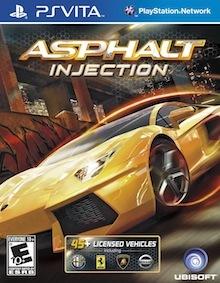Asphalt: Injection
Overview -
Like a family station wagon, the Asphalt racing series has been around the track quite a few times since its inception in 2004. Beginning life as a mobile phone, N-Gage and Nintendo DS release, the franchise has since found itself on a plethora of different platforms, with a strong footing on Apple’s iOS devices. To say that Gameloft has been busy working on these games over the years would be an understatement, having released approximately eight different iterations of its boost-filled racer to date. The last one on that list happens to be Asphalt: Injection, a cumulative launch title for Sony’s PlayStation Vita handheld.
Video Review
When it comes to visual presentation, retro is the best term to use in order to describe Asphalt: Injection. This isn’t a game that was created for Sony’s new handheld and its OLED screen from the beginning. That fact is very noticeable, as the entire experience looks dated.
Taking an in-depth look at Gameloft’s employed texture work shows that this is merely a racer that has been touched up for its latest attempt at a first place finish. It doesn’t come anywhere close to taking full advantage of the device and its impressive visual capabilities, resembling a higher resolution version of an iOS game or something that the old PSP could have run. Though, it’s important to note that the experience runs well, without any major hiccups.
During gameplay, cutaways to a crash camera are used whenever the player is involved in any destructive fender benders. This is very Burnout-esque, and while it’s nice to see other racers become eliminated from the race for a brief amount of time, this mechanic can be problematic. The race continues for a bit, while the visual overlay is shown, meaning that you may assume control of a car that is about to scrape a guardrail after viewing time is over.
The cars themselves look like their real life inspiration, albeit without the amount of detail we’re used to expecting from recently released racing experiences. They look decent, along with the large amount of tracks, which are made up based on different global locations (i.e. Rio, Detroit, and Shanghai.) There’s a nice variety in that latter list, both in terms of course and visual design, although seeing the same intro video over and over again became quite dull.
Audio Review
Narration is used sparingly, in order to add personality to the experience, in a rather retro way. Remember the days when intense action sequences in racing games would feature a young lady making one-lined remarks? Well, that’s what we have here. It’s nothing special and doesn’t really benefit or mar the experience at all.
Considering that the Asphalt series pays homage to racers from the N64 era, it’s not surprising that a narration element is included. The only interesting part of her script comes in the form of information about each location, which is played during those aforementioned intro videos. The problem is that you will hear the same line repeatedly spoken before each race on that track. It can become incredibly annoying, even though what’s said is somewhat informative.
On top of the young lady’s whoops and hollers, Asphalt: Injection features the genre’s necessary sound effects. All of them are engine, turbo, or crash based. It’s tough to find anything to complain about, as they sound OK with decent audio levels and clarity. However, there’s nothing special to be found in the audio department as a whole, even when you take the repetitive but serviceable techno soundtrack into account. Everything works, but there’s no area where this design excels.
Even though there are quite a few negatives to be found inside of Asphalt: Injection and its dated feeling design, this isn’t a bad game. Though, with that being said, it certainly falls far from being a podium contender. What PS Vita early adopters will find is a serviceable racing game that hovers over the fulcrum of mediocrity. There is some fun to be had, but this isn’t a game that friends will be clamoring over when the device is showcased. Gameloft is well known for creating games that borrow more than they innovate and Asphalt: Injection is yet another title to add to that list.
What makes this “average-at-best” game even harder to recommend is its hefty price tag, which doesn’t make a lot of sense. Asphalt: Injection is not worth that price, although a case could be made for it at a lower price point. If Ubisoft had decided to release this experience as a $10-$15 PlayStation Network download, as opposed to something retailing for double that price, it would be easier to digest. That’s not what happened, however, so I cannot easily recommend what ends up feeling like an inflated iOS port with a few sprinkles on it in an attempt to warrant the equally inflated price.












